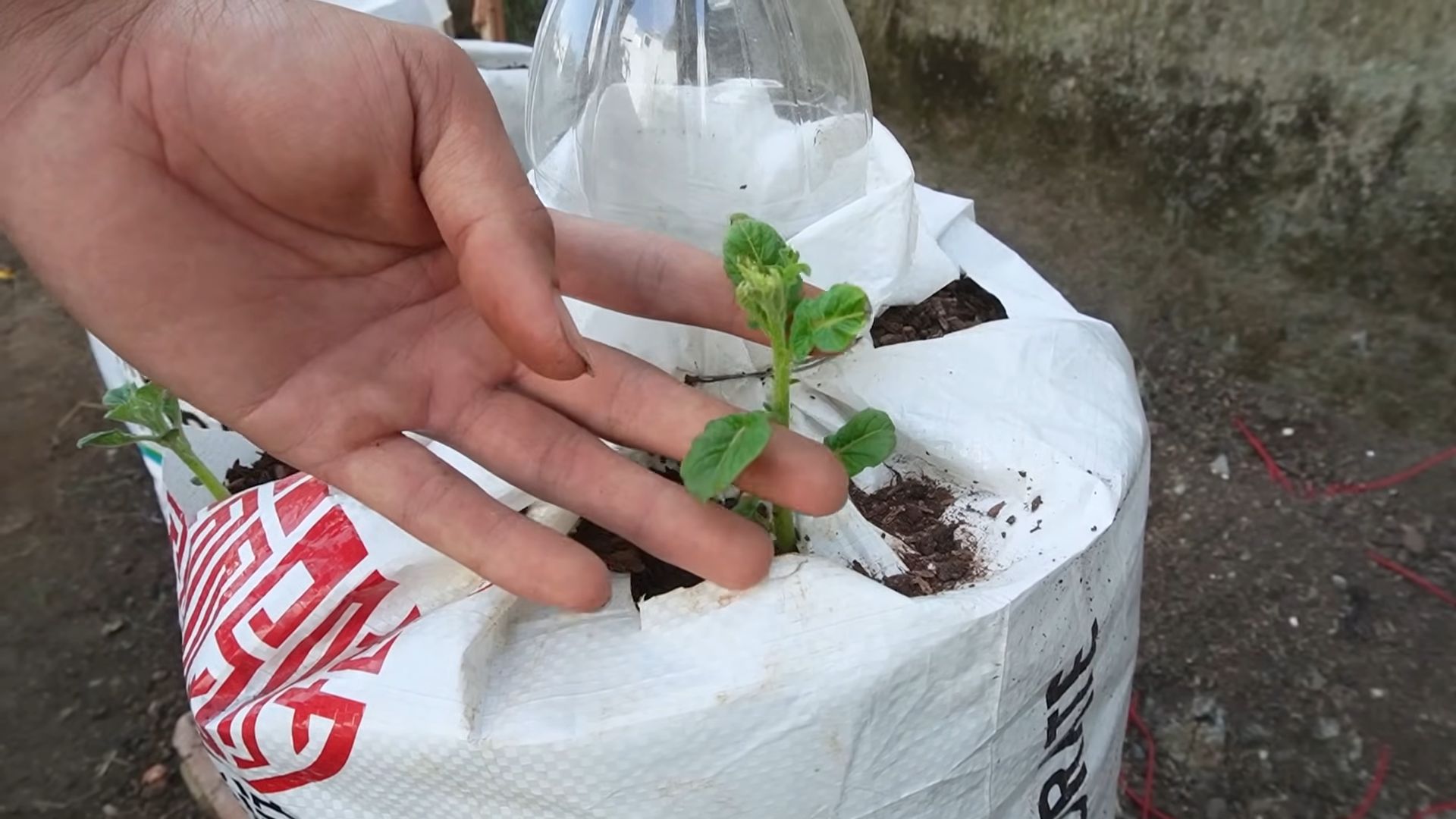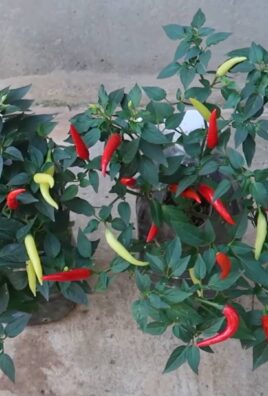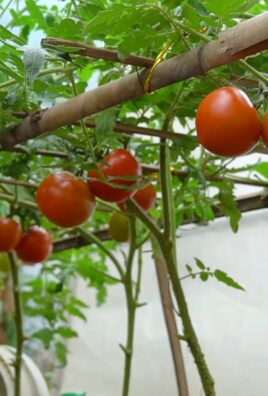Grow Potatoes at Home Easy? Absolutely! Imagine harvesting your own creamy, earthy potatoes right from your backyard – or even your balcony! It’s a surprisingly simple and rewarding experience, and I’m here to show you how. For centuries, potatoes have been a staple food around the world, originating in the Andes Mountains of South America. They’ve nourished civilizations and continue to be a versatile and beloved ingredient in countless dishes.
But why should you bother growing your own when you can just buy them at the store? Well, for starters, the taste of a freshly harvested, homegrown potato is simply unmatched. Plus, you have complete control over what goes into your food, avoiding potentially harmful pesticides and herbicides. In this DIY guide, I’ll share some easy-to-follow tricks and hacks that will help you grow potatoes at home easy, even if you have limited space or gardening experience. Get ready to dig in and discover the joy of homegrown goodness!

Grow Your Own Potatoes: A Beginner’s Guide to Bountiful Harvests!
Hey there, fellow gardening enthusiasts! Ever dreamt of digging up your own homegrown potatoes, fresh from the earth? Well, dream no more! Growing potatoes at home is surprisingly easy and incredibly rewarding. I’m going to walk you through everything you need to know, from choosing the right potatoes to harvesting your delicious crop. Let’s get our hands dirty!
Choosing Your Seed Potatoes
First things first, you can’t just plant any old potato from the grocery store. You need “seed potatoes.” These are potatoes specifically grown for planting, and they’re certified disease-free. You can find them at your local garden center or online.
Here’s what to consider when choosing your seed potatoes:
* Variety: Different potato varieties have different characteristics. Some are better for boiling, others for baking, and some are all-purpose. Do some research and choose varieties that you enjoy eating and that are well-suited to your climate. Popular choices include Yukon Gold (all-purpose), Russet (baking), and Red Pontiac (boiling).
* Size: Smaller seed potatoes (about the size of a chicken egg) can be planted whole. Larger ones should be cut into pieces, each with at least one or two “eyes” (those little buds that sprout).
* Health: Make sure your seed potatoes are firm, free of blemishes, and haven’t started to rot. A little bit of sprouting is fine, even desirable!
Preparing Your Seed Potatoes
This step is crucial, especially if you’re using larger seed potatoes. “Chitting” or “sprouting” your potatoes before planting gives them a head start.
Here’s how to chit your potatoes:
* Timing: Start chitting about 4-6 weeks before your last expected frost.
* Location: Place your seed potatoes in a cool, bright location (but not in direct sunlight). An unheated garage or shed works well.
* Arrangement: Arrange the potatoes in a single layer in egg cartons or trays, with the “eyes” facing upwards.
* Waiting Game: Over the next few weeks, the eyes will start to sprout. You want them to develop short, sturdy green sprouts.
If you’re cutting your seed potatoes, do it a day or two before planting to allow the cut surfaces to callous over. This helps prevent rot. Make sure each piece has at least two eyes.
Preparing Your Planting Area
Potatoes need well-drained soil that’s rich in organic matter. They also prefer slightly acidic soil (pH 6.0-6.5).
Here’s how to prepare your planting area:
* Location, Location, Location: Choose a spot that gets at least 6-8 hours of sunlight per day.
* Soil Preparation: Dig down at least 12 inches and loosen the soil. Remove any rocks, weeds, or debris.
* Amendments: Amend the soil with plenty of compost or well-rotted manure. This will improve drainage, fertility, and soil structure. You can also add a balanced fertilizer (like 10-10-10) according to the package directions.
* Mounding or Trenching: Potatoes are typically planted in rows, either in mounds or trenches. I prefer trenching because it’s easier to “hill” the potatoes later on (more on that below). To create trenches, dig furrows about 6-8 inches deep and 2-3 feet apart.
Planting Your Potatoes
Now for the fun part! It’s time to get those potatoes in the ground.
Follow these steps for planting:
1. Timing: Plant your potatoes about 2-3 weeks after the last expected frost, when the soil has warmed up to at least 45°F (7°C).
2. Spacing: Place your seed potatoes (or cut pieces) in the trenches, about 12 inches apart, with the sprouts facing upwards.
3. Covering: Cover the potatoes with about 4 inches of soil.
4. Watering: Water the soil thoroughly after planting.
Caring for Your Potato Plants
Once your potato plants emerge, it’s important to provide them with proper care.
Here’s what you need to do:
* Watering: Potatoes need consistent moisture, especially during tuber formation. Water deeply whenever the top inch of soil feels dry. Avoid overwatering, which can lead to rot.
* Weeding: Keep the area around your potato plants free of weeds. Weeds compete with the potatoes for nutrients and water.
* Fertilizing: Side-dress your potato plants with a balanced fertilizer every few weeks. This will provide them with the nutrients they need to grow and produce tubers.
* Hilling: This is a crucial step for maximizing your potato harvest. As the potato plants grow, gradually “hill” the soil around the stems. This encourages the plants to produce more tubers along the buried stems. You can hill the potatoes every few weeks, until the mounds are about 12 inches high.
Dealing with Pests and Diseases
Potatoes are susceptible to a few pests and diseases. Here are some common problems and how to deal with them:
* Colorado Potato Beetles: These beetles can defoliate your potato plants. Handpick them off the plants or use an organic insecticide like neem oil or spinosad.
* Flea Beetles: These tiny beetles can create small holes in the leaves. Cover your plants with row covers or use an organic insecticide.
* Potato Blight: This fungal disease can cause the leaves and stems to turn brown and die. Prevent blight by planting disease-resistant varieties, providing good air circulation, and avoiding overhead watering. If blight does occur, remove and destroy infected plants.
* Scab: This disease causes rough, scabby patches on the potato tubers. Prevent scab by maintaining a slightly acidic soil pH and avoiding overwatering.
Harvesting Your Potatoes
The moment you’ve been waiting for! It’s time to harvest your potatoes.
Here’s how to know when your potatoes are ready:
* Timing: Potatoes are typically ready to harvest about 70-100 days after planting, depending on the variety.
* Signs: The potato plants will start to flower, and the foliage will begin to turn yellow and die back.
* Test Dig: Dig up a few potatoes to check their size and maturity. If they’re the size you want and the skins are firm, it’s time to harvest.
Here’s how to harvest your potatoes:
1. Digging: Use a garden fork or shovel to carefully dig around the potato plants, being careful not to damage the tubers.
2. Lifting: Gently lift the plants and loosen the soil around the potatoes.
3. Collecting: Pick up the potatoes and brush off any excess soil.
4. Curing: Cure the potatoes by spreading them out in a cool, dark, and well-ventilated place for about a week. This will help them to develop thicker skins and store longer.
Storing Your Potatoes
Proper storage is essential for keeping your potatoes fresh and delicious.
Here’s how to store your potatoes:
* Location: Store your potatoes in a cool, dark, and dry place, such as a root cellar or basement. The ideal temperature is between 40-50°F (4-10°C).
* Container: Store the potatoes in a breathable container, such as a burlap sack or a cardboard box with holes.
* Avoid Light: Keep the potatoes away from light, which can cause them to turn green and produce solanine, a toxic compound.
* Check Regularly: Check the potatoes regularly for signs of rot or spoilage. Remove any damaged potatoes to prevent them from affecting the others.
With proper storage, your homegrown potatoes can last for several months!
Troubleshooting
Even with the best planning, things can sometimes go wrong. Here are a few common potato-growing problems and how to fix them:
* No Potatoes: If your potato plants are growing well but not producing tubers, it could be due to a lack of phosphorus in the soil. Amend the soil with bone meal or rock phosphate.
* Small Potatoes: Small potatoes can be caused by overcrowding, poor soil fertility, or insufficient watering. Thin out the plants, fertilize regularly, and water deeply.
* Green Potatoes: Green potatoes are caused by exposure to light. Avoid this by hilling the potatoes properly and storing them in a dark place.
Enjoying Your Harvest
Congratulations! You’ve successfully grown your own potatoes. Now it’s time to enjoy the fruits (or rather, tubers) of your labor.
Here are just a few ways to enjoy your homegrown potatoes:
* Roasted: Toss them with olive oil, herbs, and spices, and roast them in the oven until golden brown.
* M

Conclusion
So, there you have it! Growing potatoes at home is not only achievable, but it’s also incredibly rewarding. Forget those bland, store-bought spuds – imagine the taste of freshly harvested, homegrown potatoes gracing your dinner table. This DIY trick transforms your garden, balcony, or even a sunny corner indoors into a miniature potato farm. The satisfaction of nurturing a plant from seed potato to harvest is unparalleled, and the flavor difference is truly remarkable.
Why is this a must-try? Because it empowers you to take control of your food source, reduces your reliance on mass-produced produce, and connects you with the natural world in a tangible way. Plus, it’s a fantastic learning experience for both adults and children, teaching valuable lessons about plant life cycles and sustainable living.
But the fun doesn’t stop there! Feel free to experiment with different potato varieties. Russets are fantastic for baking and frying, Yukon Golds offer a creamy texture perfect for mashed potatoes, and fingerling potatoes add a touch of elegance to salads. You can also adjust the growing medium to suit your specific needs. Some gardeners swear by using straw as mulch, while others prefer a mix of compost and soil. Don’t be afraid to try different fertilizers to see what works best for your potatoes.
Consider companion planting to further enhance your potato-growing experience. Marigolds can help deter pests, while basil can improve the overall health of your plants. Get creative and explore the possibilities!
We’ve shown you how easy it is to grow potatoes at home, now it’s your turn to get your hands dirty. We encourage you to give this DIY trick a try. Whether you have a sprawling garden or a small patio, there’s a way to make it work for you.
And most importantly, we want to hear about your experience! Share your photos, tips, and challenges in the comments below. Let’s create a community of home potato growers and learn from each other. Together, we can cultivate a more sustainable and delicious future, one potato at a time. So, grab your seed potatoes, prepare your growing medium, and get ready to embark on a rewarding journey of homegrown goodness. Happy growing!
Frequently Asked Questions (FAQ)
What are the best potato varieties to grow at home?
The best potato variety for you depends on your taste preferences and growing conditions. Russet potatoes are a popular choice for baking and frying due to their high starch content. Yukon Gold potatoes are known for their creamy texture and buttery flavor, making them ideal for mashed potatoes and roasting. Fingerling potatoes are smaller and more elongated, offering a unique texture and flavor that’s perfect for salads and side dishes. Red potatoes are waxy and hold their shape well when cooked, making them great for boiling and potato salads. Consider your local climate and soil conditions when selecting a variety. Some varieties are more resistant to certain diseases or pests, so do your research before planting. Also, think about how you plan to use the potatoes. If you primarily want to make fries, Russets are a good choice. If you prefer mashed potatoes, Yukon Golds are a better option.
How much sunlight do potatoes need?
Potatoes need at least six to eight hours of direct sunlight per day to thrive. Sunlight is essential for photosynthesis, the process by which plants convert light energy into chemical energy for growth. If your potatoes don’t receive enough sunlight, they may produce smaller tubers or have a lower yield overall. Choose a location in your garden or on your balcony that receives ample sunlight throughout the day. If you’re growing potatoes indoors, consider using grow lights to supplement natural sunlight. Rotate your potato plants regularly to ensure that all sides receive equal exposure to light.
What kind of soil is best for growing potatoes?
Potatoes prefer well-draining, slightly acidic soil with a pH between 6.0 and 6.5. Good drainage is crucial to prevent the tubers from rotting. Amend heavy clay soil with compost, peat moss, or other organic matter to improve drainage and aeration. Sandy soil may need to be amended with compost or other organic matter to improve water retention. Conduct a soil test to determine the pH level and nutrient content of your soil. Add lime to raise the pH if it’s too acidic, or sulfur to lower the pH if it’s too alkaline. Incorporate a balanced fertilizer into the soil before planting to provide your potatoes with the nutrients they need to grow.
How often should I water my potato plants?
Water your potato plants regularly, especially during dry periods. Keep the soil consistently moist, but avoid overwatering, which can lead to root rot. Water deeply when the top inch of soil feels dry to the touch. The frequency of watering will depend on the weather conditions, soil type, and the size of your plants. During hot, dry weather, you may need to water your potatoes every day. In cooler, wetter weather, you may only need to water them every few days. Use a soaker hose or drip irrigation system to water your potatoes at the base of the plants, avoiding wetting the foliage, which can increase the risk of fungal diseases.
How do I know when my potatoes are ready to harvest?
Potatoes are typically ready to harvest when the foliage begins to turn yellow and die back. This usually occurs about 80 to 100 days after planting, depending on the variety. You can also check for maturity by digging up a few test potatoes. If the skins are thick and firm, they’re ready to harvest. If the skins are thin and easily rub off, they need more time to mature. To harvest your potatoes, carefully dig around the plants with a garden fork, being careful not to damage the tubers. Gently lift the potatoes from the soil and brush off any excess dirt. Cure your potatoes in a cool, dark, and well-ventilated place for about a week to allow the skins to harden and heal any minor cuts or bruises.
What are common pests and diseases that affect potatoes?
Potatoes can be susceptible to various pests and diseases, including potato beetles, aphids, blight, and scab. Potato beetles are leaf-eating insects that can defoliate your plants. Handpick them off the plants or use an insecticide to control them. Aphids are small, sap-sucking insects that can weaken your plants and transmit diseases. Spray them with insecticidal soap or neem oil. Blight is a fungal disease that can cause brown spots on the leaves and tubers. Prevent blight by planting disease-resistant varieties, providing good air circulation, and avoiding overhead watering. Scab is a bacterial disease that causes rough, corky lesions on the potato skins. Prevent scab by planting in well-draining soil and avoiding overwatering.
Can I grow potatoes in containers?
Yes, you can absolutely grow potatoes in containers! This is a great option for gardeners with limited space or those who want to grow potatoes on a balcony or patio. Choose a large container with drainage holes, at least 15 gallons in size. Fill the container with a well-draining potting mix. Plant your seed potatoes about 4 inches deep and water thoroughly. As the plants grow, gradually add more soil to the container, burying the stems. This encourages the formation of more tubers along the buried stems. Place the container in a sunny location and water regularly.
How do I store my harvested potatoes?
Store your harvested potatoes in a cool, dark, and well-ventilated place, such as a root cellar or basement. The ideal storage temperature is between 40 and 50 degrees Fahrenheit. Avoid storing potatoes near apples or other fruits that produce ethylene gas, as this can cause them to sprout prematurely. Store potatoes in a breathable container, such as a burlap sack or a wire basket. Check your potatoes regularly for signs of spoilage, such as soft spots or mold. Remove any spoiled potatoes to prevent them from affecting the others. Properly stored potatoes can last for several months.





Leave a Comment